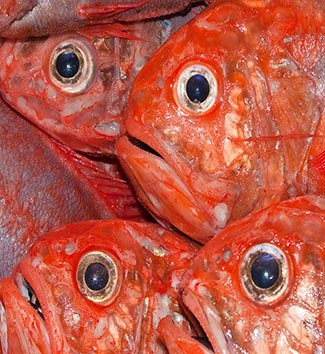An international team of marine scientists recommend ending industrial fishing in the world’s deep-sea waters because most deep sea fisheries are unsustainable. The deep sea provides less than 1% of the world’s seafood, and fishing there, especially using bottom trawlers, causes lasting damage to fishes and life on the seafloor, such as deep-sea corals, which can live hundreds of years and can’t repopulate on human time scales.
“The deep sea is the world’s worst place to catch fish” says marine ecologist Dr. Elliott Norse, the study’s lead author and President of the Marine Conservation Institute in Bellevue, Washington. “Deep-sea fishes are especially vulnerable because they can’t repopulate quickly after being overfished. Instead of overfishing the Earth’s biggest but most vulnerable ecosystem, nations should recover fish populations and fish in more productive coastal waters. Deep-sea fishes are in deep trouble almost everywhere we look. Governments shouldn’t be wasting taxpayers’ money by keeping unsustainable fisheries afloat.”
The article, published in the journal Marine Policy, documents the collapse of many deep-sea fishes around the world, including Chilean sea bass, sharks, grenadiers (rattails), blue ling, and orange roughy. According to the abstract, “As coastal fisheries around the world have collapsed, industrial fishing has spread seaward and deeper in pursuit of the last economically attractive concentrations of fishable biomass. For a seafood-hungry world depending on the oceans’ ecosystem services, it is crucial to know whether deep-sea fisheries can be sustainable.
The deep sea is by far the largest but least productive part of the oceans, although in very limited places fish biomass can be very high. Most deep-sea fishes have life histories giving them far less population resilience/productivity than shallow-water fishes, and could be fished sustainably only at very low catch rates if population resilience were the sole consideration. But like old-growth trees and great whales, their biomass makes them tempting targets while their low productivity creates strong economic incentive to liquidate their populations rather than exploiting them sustainably (Clark’s Law). Many deep-sea fisheries use bottom trawls, which often have high impacts on nontarget fishes (e.g., sharks) and invertebrates (e.g., corals), and can often proceed only because they receive massive government subsidies. The combination of very low target population productivity, nonselective fishing gear, economics that favor population liquidation and a very weak regulatory regime makes deep-sea fisheries unsustainable with very few exceptions. Rather, deep-sea fisheries more closely resemble mining operations that serially eliminate fishable populations and move on.
Instead of mining fish from the least-suitable places on Earth, an ecologically and economically preferable strategy would be rebuilding and sustainably fishing resilient populations in the most suitable places, namely shallower and more productive marine ecosystems that are closer to markets.”
Reference: Elliott A. Norse, Sandra Brooke, William W.L. Cheung, Malcolm R. Clark, Ivar Ekeland, Rainer Froese, Kristina M. Gjerde, Richard L. Haedrich, Selina S. Heppell, Telmo Morato, Lance E. Morgan, Daniel Pauly, Rashid Sumaila, Reg Watson. Sustainability of deep-sea fisheries. Marine Policy, 2012; 36 (2): 307 DOI: 10.1016/j.marpol.2011.06.008.



